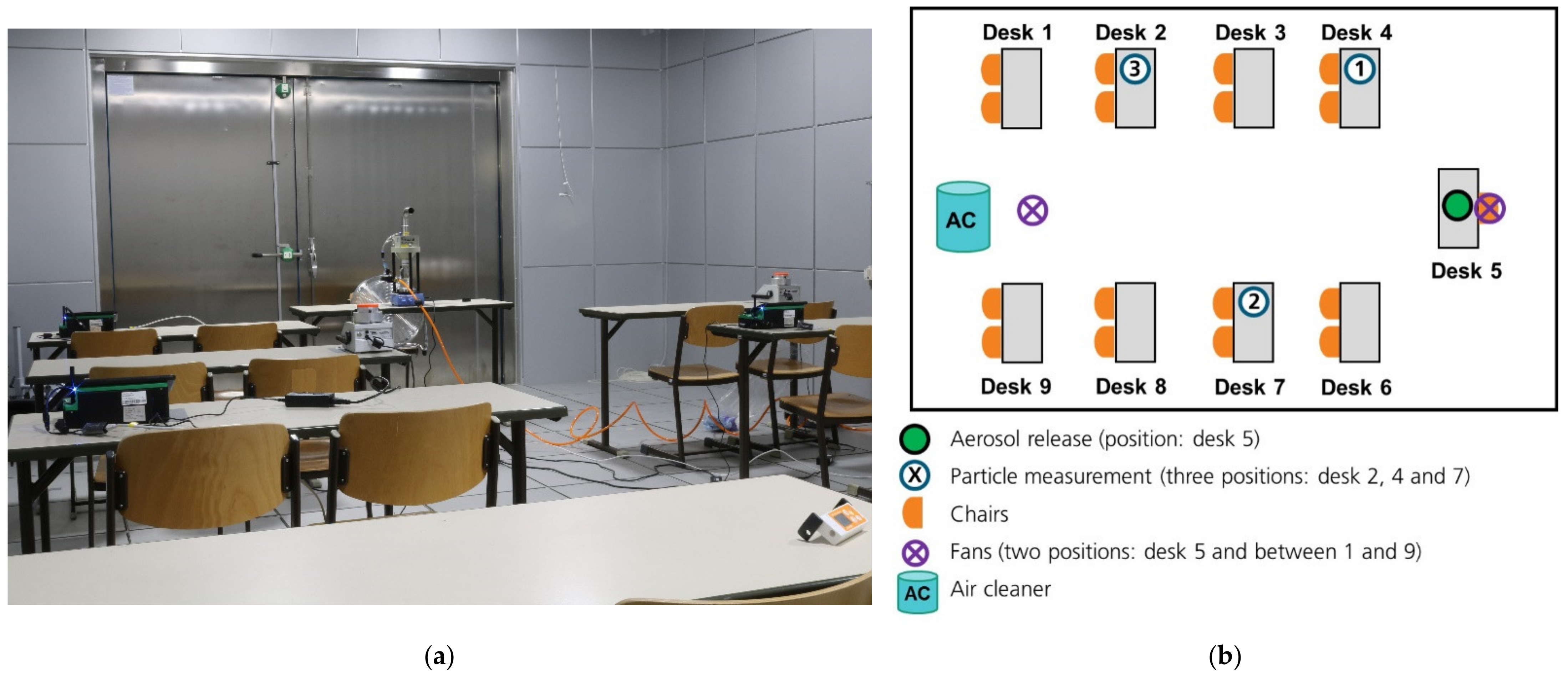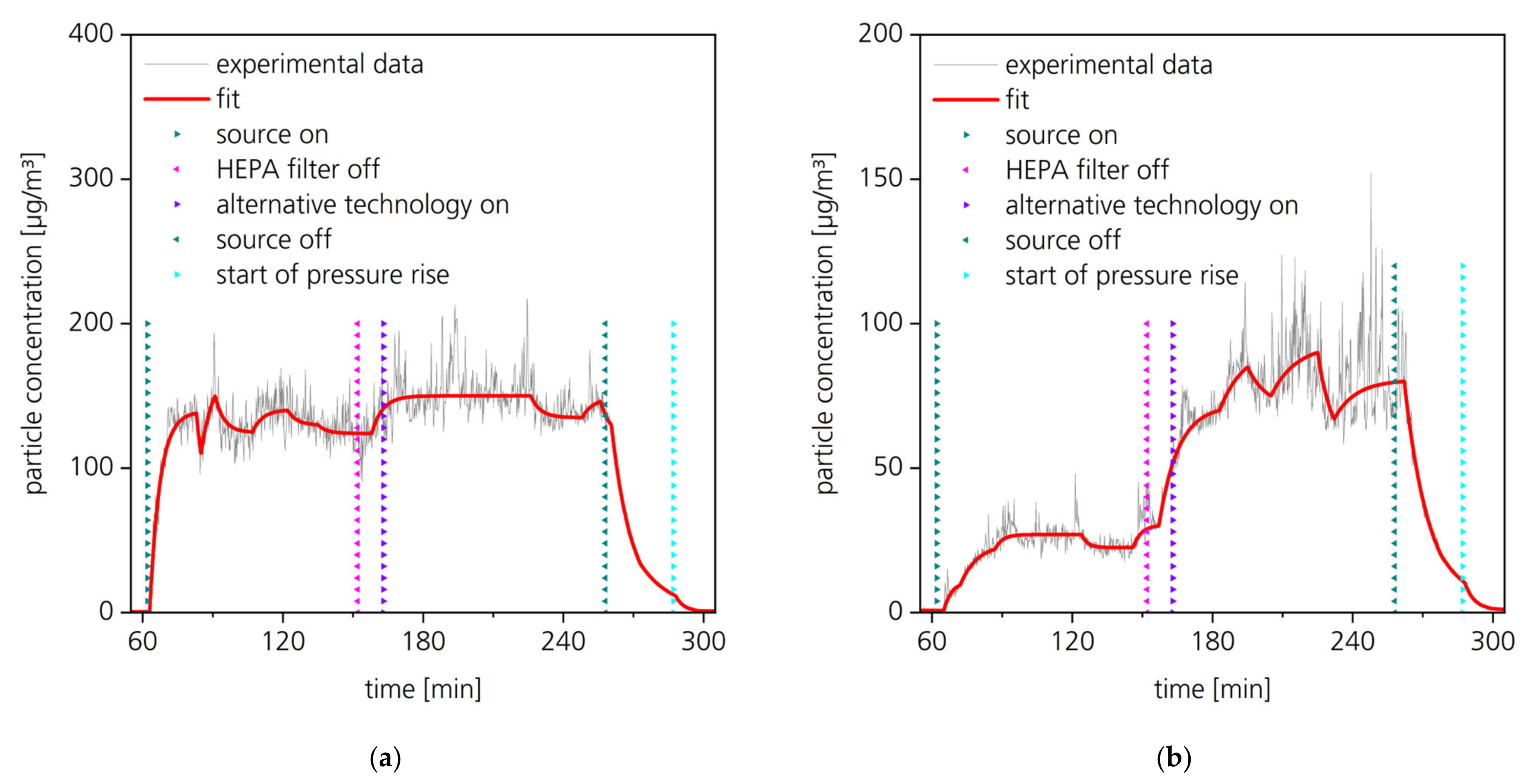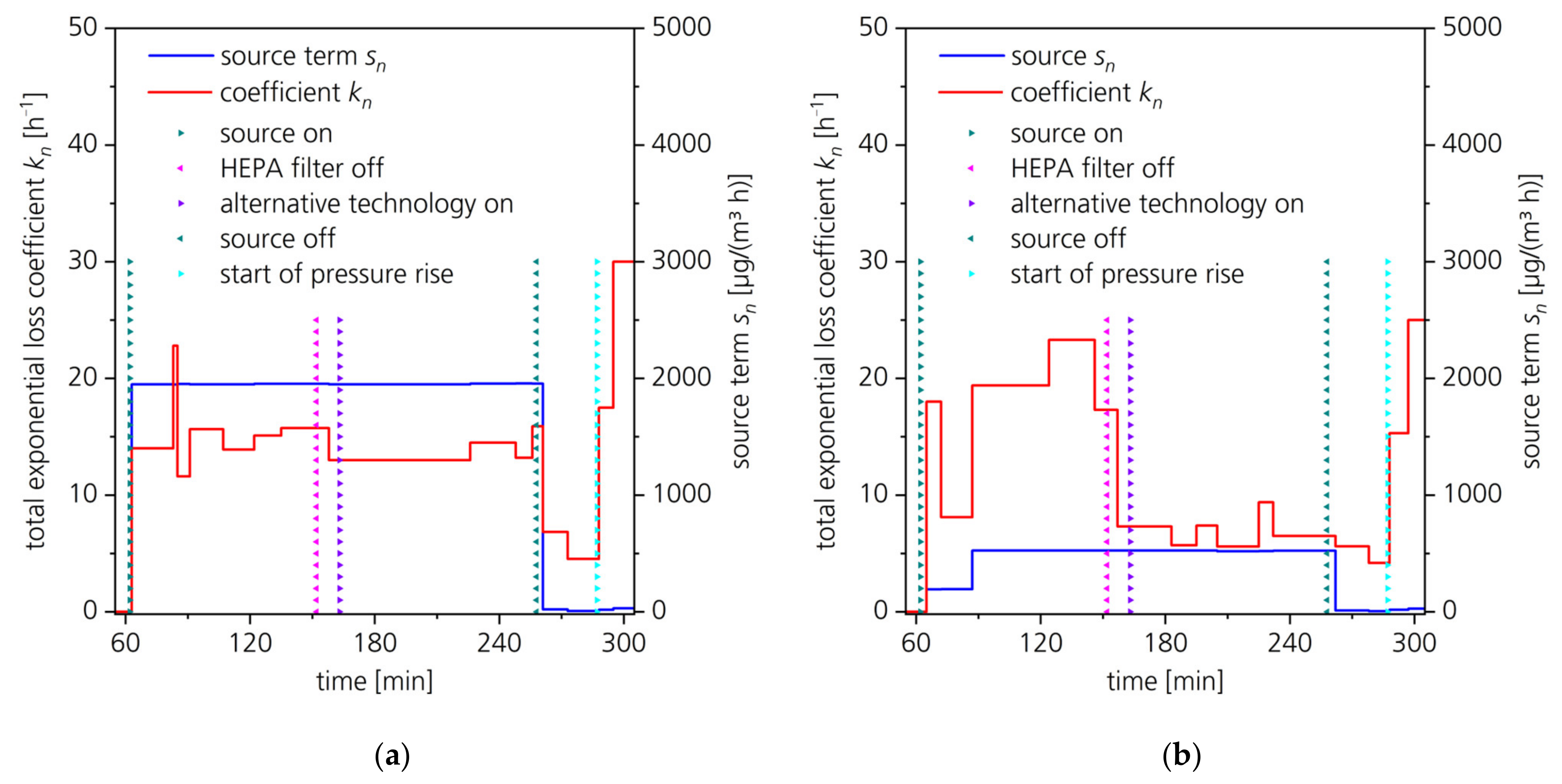Incremental Evaluation Model for the Analysis of Indoor Air Measurements
Abstract
1. Introduction
2. Materials and Methods
2.1. Materials
2.2. Test Room for Determination of Clean Air Delivery Rate (CADR)
2.3. Investigation of an Air Cleaner in an Aircraft Cabin
2.4. Mathematical Basics
2.4.1. Clean Air Delivery Rate
2.4.2. Steady State Condition
3. Results
3.1. Case Study I: Determination of a Clean Air Delivery Rate under Well Mixed Conditions
3.1.1. Fitting Function
3.1.2. Fitting Process
- The parameter knat was changed until the curvature of the curve f1(t) met the experimental data in phase 1. The parameter t1 was adjusted slightly;
- The parameter kAC was changed until the curve met the experimental data in phases 2 and 3. The parameters t2 and t3 were adjusted slightly;
- The parameter e50% was changed until the curve met the experimental data in phases 4 and 5. The parameters t4 and t5 were adjusted slightly.
3.1.3. Fitting Results
3.2. Case Study II: Investigation of an Air Cleaner in an Aircraft Cabin
3.2.1. General Aspects concerning the Fitting Model
3.2.2. Fitting Process for Phases with Active Source (sn >> 0)
3.2.3. Fitting Process for Exponential Decay until Background Concentration Is Reached
3.2.4. Fitting Process for Exponential Decay If the Concentration at the End of the Phase Is Higher Than the Background Concentration
3.2.5. Implementation of the Adjustment of the Parameters kn and sn
3.2.6. Fitting Results
4. Discussion
4.1. Case Study I: Determination of a Clean Air Delivery Rate under Well Mixed Conditions
4.2. Case Study II: Investigation of an Air Cleaner in an Aircraft Cabin
5. Conclusions and Outlook
5.1. Case Study I: Determination of a Clean Air Delivery Rate under Well Mixed Conditions
5.2. Case Study II: Investigation of an Air Cleaner in an Aircraft Cabin
5.3. Applications beyond the Presented Case Studies
- -
- Spatial and temporal resolved quantification of source terms s and total loss coefficients k;
- -
- More reliable evaluation of the local effectiveness of an air purifying technology;
- -
- Support in the identification of disturbance factors;
- -
- Determination of the spatial and temporal resolved air exchange rate in indoor spaces, e.g., by a parallel controlled release of CO2;
- -
- Assistance in the planning of experiments through the prediction of expected matter concentrations and necessary sampling volumes (analogous to Schumacher et al. [3]).
Author Contributions
Funding
Institutional Review Board Statement
Informed Consent Statement
Data Availability Statement
Conflicts of Interest
References
- Curtius, J.; Granzin, M.; Schrod, J. Testing mobile air purifiers in a school classroom: Reducing the airborne transmission risk for SARS-CoV-2. Aerosol Sci. Technol. 2021, 55, 586–599. [Google Scholar] [CrossRef]
- Küpper, M.; Asbach, C.; Schneiderwind, U.; Finger, H.; Spiegelhoff, D.; Schumacher, S. Testing of an Indoor Air Cleaner for Particulate Pollutants under Realistic Conditions in an Office Room. Aerosol Air Qual. Res. 2019, 19, 1655–1665. [Google Scholar] [CrossRef]
- Schumacher, S.; Asbach, C.; Schmid, H.-J. Effektivität von Luftreinigern zur Reduzierung des COVID-19-Infektionsrisikos/Efficacy of air purifiers in reducing the risk of COVID-19 infections. Gefahrstoffe 2021, 81, 16–28. [Google Scholar] [CrossRef]
- ANSI/AHAM AC-1-2020; Method for Measuring Performance of Portable Household Electric Room Air Cleaners. Association of Home Appliance Manufacturers: Washington, DC, USA, 2020.
- GB/T 18801-2015; Air Cleaner (Translated English version of Chinese National Standard). National Standard of the People’s Republic of China: Beijing, China, 2016.
- Wood, J. Evaluation of In-Room Particulate Matter Air Filtration Devices; EPA/600/R-08/012; Environmental Protection Agency: Washington, DC, USA, 2008; pp. 1–56.
- VDI-EE 4300 Blatt 14:2021-09; Measurement of Indoor Pollution—Requirements for Mobile Air Purifiers to Reduce Aerosol-Borne Transmission of Infectious Diseases. Verein Deutscher Ingenieure e.V.: Düsseldorf, Germany, 2021.
- Mølgaard, B.; Koivisto, A.J.; Hussein, T.; Hämeri, K. A New Clean Air Delivery Rate Test Applied to Five Portable Indoor Air Cleaners. Aerosol Sci. Technol. 2014, 48, 409–417. [Google Scholar] [CrossRef]
- Pellegrin, B.; Berne, P.; Giraud, H.; Roussey, A. Exploring the potential of electrostatic precipitation as an alternative particulate matter filtration system in aircraft cabins. Indoor Air 2022, 32, e12990. [Google Scholar] [CrossRef] [PubMed]
- Reed, C.; Nabinger, S.J.; Emmerich, S.J. Measurement and simulation of the indoor air quality impact of gaseous air cleaners in a test house. Proc. Indoor Air 2002, 2, 652–657. [Google Scholar]
- Chan, W.R.; Logue, J.M.; Wu, X.; Klepeis, N.E.; Fisk, W.J.; Noris, F.; Singer, B.C. Quantifying fine particle emission events from time-resolved measurements: Method description and application to 18 California low-income apartments. Indoor Air 2018, 28, 89–101. [Google Scholar] [CrossRef] [PubMed]
- Jung, H. Modeling CO2 Concentrations in Vehicle Cabin; SAE Technical Paper 2013-01-1497; SAE International: Warrendale, PA, USA, 2013; pp. 1–6. [Google Scholar] [CrossRef]
- Burdack-Freitag, A.; Buschhaus, M.; Grün, G.; Hofbauer, W.K.; Johann, S.; Nagele-Renzl, A.M.; Schmohl, A.; Scherer, C.R. Particulate Matter versus Airborne Viruses—Distinctive Differences between Filtering and Inactivating Air Cleaning Technologies. Atmosphere 2022, 13, 1575. [Google Scholar] [CrossRef]
- Manoukian, A.; Quivet, E.; Temime-Roussel, B.; Nicolas, M.; Maupetit, F.; Wortham, H. Emission characteristics of air pollutants from incense and candle burning in indoor atmospheres. Environ. Sci. Pollut. Res. 2013, 20, 4659–4670. [Google Scholar] [CrossRef]
- Bivolarova, M.; Ondráček, J.; Melikov, A.; Ždímal, V. A comparison between tracer gas and aerosol particles distribution indoors: The impact of ventilation rate, interaction of airflows, and presence of objects. Indoor Air 2017, 27, 1201–1212. [Google Scholar] [CrossRef] [PubMed]
- Nazaroff, W.W.; Cass, G.R. Mathematical modeling of indoor aerosol dynamics. Environ. Sci. Technol. 1989, 23, 157–166. [Google Scholar] [CrossRef]
- Nazaroff, W.W. Indoor particle dynamics. Indoor Air 2004, 14, 175–183. Available online: https://escholarship.org/uc/item/7sq4x34d (accessed on 29 August 2022). [CrossRef] [PubMed]
- Nazaroff, W.W. Indoor bioaerosol dynamics. Indoor Air 2016, 26, 61–78. [Google Scholar] [CrossRef] [PubMed]
- Silcott, D.; Kinahan, S.; Santarpia, J. TRANSCOM/AMC Commercial Aircraft Cabin Aerosol Dispersion Tests. 2020. Available online: https://www.ustranscom.mil/cmd/docs/TRANSCOM%20Report%20Final.pdf (accessed on 29 August 2022).
- Zee, M.; Davis, A.C.; Clark, A.D.; Wu, T.; Jones, S.P.; Waite, L.L.; Cummins, J.J.; Olson, N.A. Computational fluid dynamics modeling of cough transport in an aircraft cabin. Sci. Rep. 2021, 11, 23329. [Google Scholar] [CrossRef] [PubMed]
- Matheis, C.; Norrefeldt, V.; Will, H.; Herrmann, T.; Noethlichs, B.; Eckhardt, M.; Stiebritz, A.; Jansson, M.; Schön, M. Modeling the Airborne Transmission of SARS-CoV-2 in Public Transport. Atmosphere 2022, 13, 389. [Google Scholar] [CrossRef]
- Woodward, H.; Fan, S.; Bhagat, R.K.; Dadonau, M.; Wykes, M.D.; Martin, E.; Hama, S.; Tiwari, A.; Dalziel, S.B.; Jones, R.L.; et al. Air Flow Experiments on a Train Carriage—Towards Understanding the Risk of Airborne Transmission. Atmosphere 2021, 12, 1267. [Google Scholar] [CrossRef]
- Schmohl, A.; Nagele-Renzl, A.M.; Buschhaus, M.; Johann, S.; Scherer, C.R.; Grün, G.; Hofbauer, W.K.; Burdack-Freitag, A. Determination of CADR of virus-inactivating air purifiers by surrogate virus plaque assay. In Proceedings of the Indoor Air 2022, 17th International Conference of the International Society of Indoor Air Quality & Climate, Kuopio, Finland, 12–16 June 2022; pp. 1–8. [Google Scholar]
- AHAM AC-5-2022; Method for Assessing the Reduction Rate of Key Bioaerosols by Portable Air Cleaners Using an Aerobiology Test Chamber. Association of Home Appliance Manufacturers: Washington, DC, USA, 2022.
- Baer, A.; Kehn-Hall, K. Viral concentration determination through plaque assays: Using traditional and novel overlay systems. J. Vis. Exp. 2014, 93, e52065. [Google Scholar] [CrossRef] [PubMed]
- DIN EN 13610:2003-06; Chemische Desinfektionsmittel—Quantitativer Suspensionsversuch zur Bestimmung der Viruziden Wirkung Gegenüber Bakteriophagen von Chemischen Desinfektionsmitteln in den Bereichen Lebensmittel und Industrie—Prüfverfahren und Anforderungen (Phase 2, Stufe 1). Deutsche Fassung EN 13610:2003; Deutsches Institut für Normung e.V.: Berlin, Germany, 2003.
- Norrefeldt, V.; Buschhaus, M.; Nagele-Renzl, A.M. European Patent Application: Aerosolgenerator und Verfahren zur Abgabe eines Aerosols. Patent Application No. 21212872.2, 7 December 2021. [Google Scholar]
- Dbouk, T.; Roger, F.; Drikakis, D. Reducing indoor virus transmission using air purifiers. Phys. Fluids 2021, 33, 103301. [Google Scholar] [CrossRef] [PubMed]
- Burgmann, S.; Janoske, U. Transmission and reduction of aerosols in classrooms using air purifier systems. Phys. Fluids 2021, 33, 033321. [Google Scholar] [CrossRef] [PubMed]






| Time of Day | tevent [h] | Event |
|---|---|---|
| 11:30 | −0.50 | Start of particle measurement |
| 12:00 | 0.00 | Aerosol release was switched on. |
| 13:00 | 1.00 | Air cleaner with 100% power level was switched on. |
| 14:00 | 2.00 | Aerosol release was switched off. |
| 14:40 | 2.67 | Aerosol release was switched on and air cleaner reduced from 100% to 50% power level. |
| 15:40 | 3.67 | Aerosol release was switched off. |
| 17:00 | 5.00 | End of particle measurement |
| Time of Day | tevent [min] | Event |
|---|---|---|
| 08:00 | −30 | Ventilation with HEPA filter switched on |
| 08:38 | 8 | Start of particle measurement |
| 09:17 | 47 | Takeoff (pressure drop from 946 hPa to 750 hPa) |
| 09:31 | 61 | Cruising altitude reached (750 hPa) |
| 09:32 | 62 | Start of aerosol release (Sheffield head close to position 1) |
| 10:30 | 120 | Start of phage sampling |
| 11:00 | 150 | End of phage sampling |
| 11:02 | 152 | HEPA filter removed |
| 11:13 | 163 | Alternative technology on |
| 12:13 | 223 | Start of phage sampling |
| 12:43 | 253 | End of phage sampling |
| 12:48 | 258 | End of aerosol release |
| 13:17 | 287 | Descent (pressure rise from 750 hPa to 946 hPa) |
| 13:21 | 291 | Alternative technology off |
| 13:34 | 304 | Landing (946 hPa) |
| 13:35 | 305 | End of particle measurement |
| Phase n * | Start tn−1 | End tn | |||
|---|---|---|---|---|---|
| n | tn−1 | tn | with | ||
| 1 | 0 | 1.00 | with | ||
| 2 | 1.00 | 2.00 | with | ||
| 3 | 2.00 | 2.67 | with | ||
| 4 | 2.67 | 3.67 | with | ||
| 5 | 3.67 | 5.00 | with |
| Phase n * [-] | tn−1 (Start) [h] | knat [h−1] | kAC [h−1] | AC Power Level p | AC Efficiency e | Release r | kn [h−1] | fstart,n [-] | feq,n [-] |
|---|---|---|---|---|---|---|---|---|---|
| 1 | 0.00 | 0.5 | 3.0 | 0% (off) | - | 1 (on) | 0.5 | 0.00 | 2.51 |
| 2 | 1.02 | 0.5 | 3.0 | 100% (on) | e100% = 1 | 1 (on) | 3.5 | 1.00 | 0.36 |
| 3 | 2.02 | 0.5 | 3.0 | 100% (on) | e100% = 1 | 0 (off) | 3.5 | 0.38 | 0.00 |
| 4 | 2.68 | 0.5 | 3.0 | 50% (on) | e50% = 1.14 | 1 (on) | 2.21 | 0.04 | 0.57 |
| 5 | 3.68 | 0.5 | 3.0 | 50% (on) | e50% = 1.14 | 0 (off) | 2.21 | 0.52 | 0.00 |
| Position in Cabin | Phase n * [-] | tn (Start) # [min] | kn [h−1] | Uncertainty Factor of kn | sn [(µg/m3)/h] | Uncertainty Factor of sn | cstart,n [µg/m3] | ceq,n [µg/m3] |
|---|---|---|---|---|---|---|---|---|
| Position 1 | 1 | 63.5 | 17.0 | 1.4 | 4420 | 1.4 | 1.0 | 260 |
| 2 | 259.7 | 28.3 | 1.1 | 435 | 2.0 | 260 | 9.2 | |
| 3 | 260.9 | 15.8 | 1.05 | 94 | 2.0 | 148 | 3.5 | |
| 4 | 262 | 9.3 | 1.05 | 23 | 2.0 | 111 | 2.4 | |
| 5 | 266 | 6.7 | 1.05 | 11 | 2.0 | 60.0 | 1.6 | |
| 6 | 270 | 5.3 | 1.05 | 7 | 2.0 | 38.8 | 1.3 | |
| 7 | 274 | 5.1 | 1.05 | 5 | 1.9 | 27.5 | 1.0 | |
| 8 | 283 | 3.9 | 1.05 | 4 | 1.7 | 13.4 | 1.0 | |
| 9 | 289 | 15.7 | 1.05 | 14 | 1.2 | 9.4 | 1.0 | |
| 10 | 294 | 30.0 | 1.05 | 2 | 1.2 | 3.4 | 0.4 |
| Position in Cabin | Phase n * [-] | tn (Start) # [min] | kn [h−1] | Uncertainty Factor of kn | sn [(µg/m3)/h)] | Uncertainty Factor of sn | cstart,n [µg/m3] | ceq,n [µg/m3] |
|---|---|---|---|---|---|---|---|---|
| Position 2 | 1 | 63 | 14.0 | 1.5 | 1950 | 1.5 | 0.5 | 139 |
| 2 | 83 | 22.8 | 2.0 | 1947 | 2.9 | 138 | 85.4 | |
| 3 | 85 | 11.6 | 2.0 | 1952 | 1.8 | 110 | 168 | |
| 4 | 91 | 15.65 | 2.0 | 1950 | 2.0 | 150 | 125 | |
| 5 | 107 | 13.9 | 2.0 | 1950 | 2.0 | 125 | 140 | |
| 6 | 122 | 15.1 | 2.0 | 1953 | 2.0 | 140 | 129 | |
| 7 | 135 | 15.75 | 2.0 | 1953 | 2.0 | 130 | 124 | |
| 8 | 158 | 13.0 | 2.0 | 1950 | 2.0 | 124 | 150 | |
| 9 | 226 | 14.5 | 2.0 | 1956 | 2.0 | 150 | 135 | |
| 10 | 248 | 13.2 | 2.0 | 1957 | 2.0 | 135 | 148 | |
| 11 | 256 | 15.9 | 2.0 | 1956 | 2.2 | 146 | 123 | |
| 12 | 261 | 6.84 | 1.1 | 21 | 2.0 | 130 | 3.1 | |
| 13 | 273 | 4.53 | 1.1 | 6 | 2.0 | 32 | 1.3 | |
| 14 | 288 | 17.5 | 1.1 | 17 | 1.4 | 11 | 1.0 | |
| 15 | 295 | 30.0 | 1.1 | 30 | 1.0 | 2.3 | 1.0 | |
| Position 3 | 1 | 65 | 18.0 | 2.0 | 193 | 1.7 | 0.7 | 10.7 |
| 2 | 72 | 8.1 | 1.4 | 194 | 1.3 | 9.5 | 23.9 | |
| 3 | 87 | 19.4 | 2.0 | 524 | 2.0 | 22.0 | 27.0 | |
| 4 | 124 | 23.3 | 2.0 | 524 | 2.0 | 27.0 | 22.5 | |
| 5 | 146 | 17.3 | 2.0 | 525 | 1.9 | 22.5 | 30.3 | |
| 6 | 157 | 7.3 | 1.4 | 524 | 1.4 | 30.0 | 71.8 | |
| 7 | 183 | 5.7 | 2.0 | 525 | 1.8 | 70.0 | 92.1 | |
| 8 | 195 | 7.4 | 2.0 | 525 | 2.2 | 85.0 | 70.9 | |
| 9 | 205 | 5.6 | 2.0 | 519 | 1.8 | 75.0 | 101.1 | |
| 10 | 225 | 9.4 | 2.0 | 521 | 2.4 | 94.0 | 61.1 | |
| 11 | 232 | 6.5 | 2.0 | 523 | 2.0 | 67.0 | 80.5 | |
| 12 | 262 | 5.61 | 1.1 | 12 | 2.0 | 81.0 | 2.1 | |
| 13 | 278 | 4.19 | 1.1 | 5 | 2.0 | 19.0 | 1.1 | |
| 14 | 288 | 15.3 | 1.1 | 17 | 1.2 | 10.0 | 1.1 | |
| 15 | 297 | 25.0 | 1.1 | 27 | 1.0 | 2.0 | 1.1 |
| Phase n | tstart [h] | Aerosol Release | Air Cleaner | Both Fans | Purpose |
|---|---|---|---|---|---|
| 1 | 0.0 | on | off | on | determination of knat,start under ideal, well-mixed conditions |
| 2 | 1.00 | on | on | on | 2 & 3: determination of kAC,ideal under ideal, well-mixed conditions |
| 3 | 1.67 | off | on | on | |
| 4 | 2.33 | on | on | off | 4 & 5: determination of kAC,real under realistic conditions |
| 5 | 3.00 | off | on | off | |
| 6 | 3.67 | on | off | on | proof of stable aerosol generation by comparison with phase 1 |
| 7 | 4.33 * | off | off | on | proof of stable knat by comparison of knat,end (n = 7) with knat,start (n = 1) |
Publisher’s Note: MDPI stays neutral with regard to jurisdictional claims in published maps and institutional affiliations. |
© 2022 by the authors. Licensee MDPI, Basel, Switzerland. This article is an open access article distributed under the terms and conditions of the Creative Commons Attribution (CC BY) license (https://creativecommons.org/licenses/by/4.0/).
Share and Cite
Schmohl, A.; Buschhaus, M.; Norrefeldt, V.; Johann, S.; Burdack-Freitag, A.; Scherer, C.R.; Vega Garcia, P.A.; Schwitalla, C. Incremental Evaluation Model for the Analysis of Indoor Air Measurements. Atmosphere 2022, 13, 1655. https://doi.org/10.3390/atmos13101655
Schmohl A, Buschhaus M, Norrefeldt V, Johann S, Burdack-Freitag A, Scherer CR, Vega Garcia PA, Schwitalla C. Incremental Evaluation Model for the Analysis of Indoor Air Measurements. Atmosphere. 2022; 13(10):1655. https://doi.org/10.3390/atmos13101655
Chicago/Turabian StyleSchmohl, Andreas, Michael Buschhaus, Victor Norrefeldt, Sabine Johann, Andrea Burdack-Freitag, Christian R. Scherer, Pablo A. Vega Garcia, and Christoph Schwitalla. 2022. "Incremental Evaluation Model for the Analysis of Indoor Air Measurements" Atmosphere 13, no. 10: 1655. https://doi.org/10.3390/atmos13101655
APA StyleSchmohl, A., Buschhaus, M., Norrefeldt, V., Johann, S., Burdack-Freitag, A., Scherer, C. R., Vega Garcia, P. A., & Schwitalla, C. (2022). Incremental Evaluation Model for the Analysis of Indoor Air Measurements. Atmosphere, 13(10), 1655. https://doi.org/10.3390/atmos13101655







